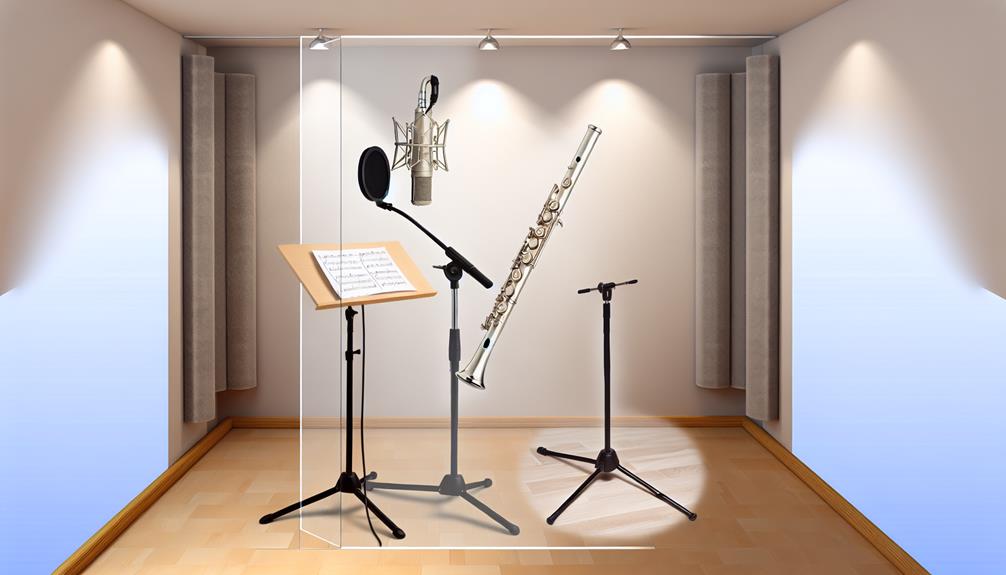Maintaining your flute in optimal condition requires more than just occasional attention. From regular cleaning routines to meticulous inspections and professional consultations, the care of your instrument can significantly impact its performance and longevity. By understanding the nuances of flute maintenance, you can ensure that each note resonates with clarity and precision. In the world of musical instruments, where precision and craftsmanship are paramount, the upkeep of your flute is a task that demands attention to detail and commitment.
Key Takeaways
- Clean flute components regularly to remove dirt and grime, maintaining a polished appearance.
- Oil key mechanisms every 3-6 months to ensure smooth operation and prevent damage.
- Inspect flute for damage like cracks or bent keys to address issues promptly and prevent further damage.
- Adjust screws and rods for proper alignment and function, using specialized tools as needed.
- Check and replace worn pads to maintain optimal playability and prevent issues during performances.
Cleaning Your Flute Regularly
How should one effectively maintain the cleanliness of their flute to ensure optimal performance and longevity? Proper techniques and cleaning tools are essential for keeping your flute in top shape. To start, always begin by disassembling the flute carefully, separating each piece to allow for thorough cleaning. Use a soft, clean cloth to wipe down the surface of each piece, removing any dirt, oils, or moisture that may have accumulated during use.
When it comes to the interior of the flute, a cleaning rod with a cloth should be used to gently swab out the inside of each section. Be cautious not to use excessive force, as this could damage the delicate mechanism inside. Additionally, a small amount of mild dish soap diluted in warm water can be used to clean the mouthpiece and lip plate, ensuring that all saliva and residue are removed.
For the keys and tone holes, a key brush can be utilized to remove any debris that may have built up over time. It's important to be gentle and thorough to prevent any blockages or malfunctions. Finally, after cleaning all parts of the flute, reassemble it carefully and use a polishing cloth to give the entire instrument a final shine.
Oiling the Key Mechanisms
To maintain the optimal functionality and longevity of your flute, proper and regular oiling of the key mechanisms is crucial. Key maintenance is a fundamental aspect of caring for your woodwind instrument, ensuring smooth key action and preventing wear and tear. When it comes to lubrication techniques, using a high-quality key oil specifically designed for instruments like flutes is essential.
Begin by carefully disassembling the flute and laying out the keys in the order they will be reassembled. Apply a small amount of key oil to each pivot point and carefully work the keys back and forth to distribute the oil evenly. Be cautious not to over-oil, as excess oil can attract dirt and lead to sticky key mechanisms.
It's recommended to oil the key mechanisms every 3-6 months, depending on how frequently you play the flute. Regularly oiling the keys will not only keep them moving freely but also prevent corrosion and damage to the delicate metal components. This simple maintenance task is a key part of woodwind instrument care essentials, contributing to the overall performance and lifespan of your flute.
Inspecting for Signs of Damage
Upon visual inspection of your flute, meticulously examine all components for any signs of damage that may affect its performance or structural integrity. Regularly checking for damage is crucial in maintaining your flute's optimal condition and preventing more severe issues. Here is a table outlining common flute issues to look out for and possible repair options:
| Common Flute Issues | Troubleshooting Guide | Damage Prevention | Repair Options |
|---|---|---|---|
| Sticky keys | Check for debris or moisture causing the issue. | Keep the flute clean and dry. | Key adjustment or replacement. |
| Loose tenons | Ensure proper assembly and alignment of parts. | Handle the flute carefully during assembly and disassembly. | Tenon tightening or replacement. |
| Cracks in the body | Inspect the body for any visible cracks. | Store the flute in a suitable case when not in use. | Crack repair by a professional technician. |
| Bent keys | Look for misaligned or bent keys. | Handle the flute gently, avoiding excessive force. | Key realignment or replacement. |
Adjusting Screws and Rods
Inspecting and adjusting screws and rods on your flute is a meticulous process that requires precision and attention to detail to ensure optimal performance and functionality. When it comes to screw adjustments and tuning, it is crucial to use the appropriate tools and techniques to make precise changes. Start by checking the tightness of the screws that hold key mechanisms in place. Loose screws can affect the overall playability of the flute, causing key misalignment and affecting tone quality. Use a screwdriver that fits the screw heads perfectly to avoid stripping the screws.
In terms of rod maintenance and alignment, it is essential to ensure that all rods are straight and properly aligned. Bent or misaligned rods can lead to key binding issues and hinder the flute's ability to produce clear and consistent notes. Carefully inspect each rod, gently straightening any that appear bent using a specialized rod straightening tool. Additionally, check for any rods that may have come loose and reattach them securely to their respective key mechanisms.
Regularly adjusting screws and rods on your flute will not only enhance its performance but also prolong its lifespan. By paying close attention to these details, you can maintain your flute in top shape and enjoy playing it for years to come.
Checking and Replacing Pads
Ensuring the integrity and functionality of the pads on your flute is a critical aspect of maintenance for maintaining optimal playability and tone quality. Regularly checking the condition of the pads and promptly addressing any issues is essential to prevent air leaks and maintain a consistent sound. Proper care and maintenance of the pads can significantly prolong the life of your instrument and ensure a pleasant playing experience.
When inspecting the pads, look for signs of wear, tears, or flattening. If you notice any of these issues, it may be time for pad replacement. Replacing pads should be done by a qualified technician to ensure proper alignment and sealing. It is advisable to have a professional check the pads annually or whenever you suspect a problem.
Below is a table outlining key points for pad maintenance and replacement:
| Aspect | Description | Frequency |
|---|---|---|
| Pad Inspection | Check for wear, tears, or flattening of pads. | Regularly |
| Pad Replacement | Seek professional help for pad replacement. | As needed |
| Pad Care | Keep pads dry, avoid contact with liquids. | Daily |
Proper Storage Practices
To maintain the condition and functionality of your flute over time, implementing proper storage practices is crucial. Proper storage not only protects your instrument from damage but also ensures that it performs optimally for years to come. Here are some essential storage practices to keep your flute in top shape:
- Humidity Control: Fluctuations in humidity can be detrimental to a flute's delicate mechanisms and pads. Store your flute in a room with stable humidity levels, ideally between 40-60%. Consider using a humidifier in dry climates and a dehumidifier where humidity levels are high.
- Protective Cases: Invest in a high-quality, snug-fitting flute case to shield your instrument from dust, moisture, and physical damage. A case with a soft interior lining will prevent scratches and dents, while a hard outer shell provides protection during travel.
- Vertical Storage: Storing your flute vertically, with the head joint up and the foot joint down, helps prevent moisture from accumulating in the instrument. This position allows any condensation to drain out of the flute instead of pooling inside.
- Temperature Regulation: Extreme temperatures can warp the metal of your flute and affect its tuning. Keep your flute away from direct sunlight, heaters, air conditioners, and drafty areas. Store it in a moderate temperature environment to maintain its structural integrity.
Preventing Tarnish and Corrosion
Properly storing your flute is fundamental to maintaining its condition and functionality, and an integral aspect of this maintenance is preventing tarnish and corrosion. Tarnish, a form of oxidation, can affect the appearance and sound quality of your flute, while corrosion can damage its metal components. To prevent these issues, there are several corrosion prevention techniques that you can implement.
Firstly, after playing, it's essential to clean your flute thoroughly with a soft, dry cloth to remove any moisture or debris that could contribute to tarnishing or corrosion. Pay close attention to areas where moisture tends to accumulate, such as around keys and tone holes.
Additionally, storing your flute in a dry environment away from extreme temperatures and humidity levels can help prevent oxidation.
Using tarnish-prevention products such as anti-tarnish strips or cases lined with anti-tarnish material can also be beneficial in protecting your flute from corrosion. These products work by absorbing moisture and neutralizing harmful gases that may cause oxidation.
Regularly inspecting your flute for any signs of tarnish or corrosion and addressing them promptly can prevent further damage and prolong the life of your instrument.
Consulting a Professional Technician
For expert assessment and maintenance of your flute, engaging a certified professional technician is paramount to ensuring optimal performance and longevity of your instrument. A skilled technician possesses the expertise and specialized tools necessary to address a wide range of flute issues effectively.
Here are some reasons why consulting a professional technician is crucial:
- Specialized Knowledge: Technicians have in-depth knowledge of flute construction and mechanisms, enabling them to identify and rectify issues accurately.
- Precision Repairs: Professional technicians can conduct intricate repairs with precision, ensuring that your flute functions flawlessly.
- Quality Assurance: By entrusting your flute to a certified technician, you can be confident that the repairs and maintenance performed are of the highest quality.
- Recommendations for Care: Technicians can provide valuable advice on proper care practices to prolong your flute's lifespan and maintain its optimal performance.
While it may be tempting to attempt DIY repairs or troubleshooting techniques, these actions can sometimes do more harm than good if not executed correctly. Consulting a professional technician is a wise investment in the health of your instrument, as they can offer tailored solutions and expert guidance to keep your flute in top shape.
Frequently Asked Questions
Can I Use Regular Household Oil for Oiling the Key Mechanisms?
Using regular household oil as a substitute for oils specifically designed for lubricating key mechanisms in your flute is not recommended. Household oils may contain additives or impurities that could potentially damage the delicate components of the flute over time.
It is advisable to use oils that are specifically formulated for musical instruments to ensure proper lubrication and maintenance of your flute's key mechanisms, thus preserving its longevity and performance quality.
How Often Should I Check for Signs of Damage on My Flute?
Regularly checking for signs of damage on your flute is crucial to maintaining its optimal condition. A recommended practice is to inspect your flute for any visible wear or structural issues after each use.
Implementing a cleaning routine and maintenance schedule can help prevent costly repairs in the future. DIY fixes can address minor issues, but for more complex problems, professional repair costs may vary.
Stay vigilant in detecting signs of damage to keep your flute in top shape.
What Tools Do I Need to Adjust Screws and Rods on My Flute?
To adjust screws and rods on your flute, you will need a precision screwdriver set for flute maintenance.
When adjusting rods, consider using a specialized rod adjustment tool to ensure proper alignment.
Additionally, having various lubricant options such as key oil or cork grease on hand will aid in smooth adjustments.
These maintenance tools are essential for keeping your flute in optimal playing condition and ensuring longevity of the instrument.
How Can I Tell if the Pads on My Flute Need Replacing?
Assessing the pads of a flute is crucial for maintaining optimal performance. Signs indicating the need for replacement include visible wear, leaks, or a lack of seal when closed.
Proper maintenance involves regular inspections of pad condition, ensuring they are clean, dry, and undamaged. Addressing pad issues promptly can prevent further damage to the instrument and maintain its tonal quality.
Maintaining the pads is an essential aspect of flute care to ensure longevity and performance quality.
Is It Necessary to Store My Flute in a Specific Temperature or Humidity Level?
Proper storage of a flute is essential to maintain its condition. Flutes should be stored in a location with controlled temperature and humidity levels. Extreme temperatures and high humidity can damage the instrument.
Optimal conditions are typically around 65-72°F with a humidity level of 40-60%. Utilizing a hard case with a soft interior lining can also help protect the flute from temperature and humidity fluctuations, enhancing its longevity and performance.
Conclusion
In conclusion, maintaining your flute is like tending to a delicate garden – meticulous care and attention to detail ensure its beauty and longevity.
Regular cleaning, oiling, inspections, adjustments, and proper storage are essential for keeping your instrument in top shape.
By following these maintenance tips diligently and consulting a professional technician when needed, you can ensure that your flute performs at its best, allowing you to create beautiful music for years to come.




